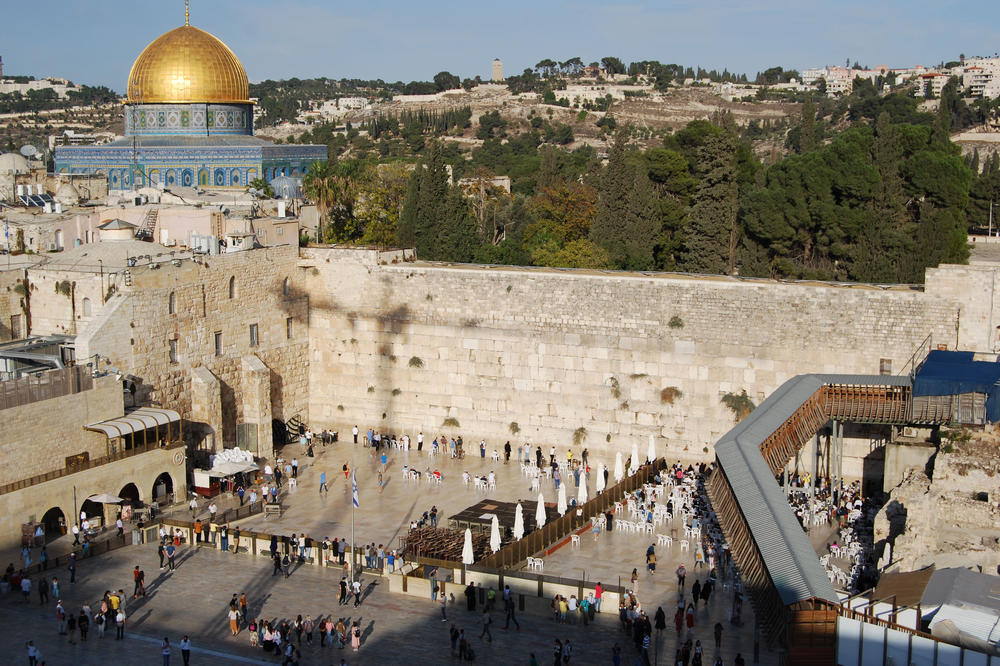Shalom from Jerusalem!
Julian Jestadt has been studying philosophy in Israel since October and is sending us “Letters from Jerusalem”
Nov 05, 2019
Julian Jestadt on a lookout point near the Rothberg International School on Mount Scopus. The wall separating the West Bank from Israel is in the background on the left.
Image Credit: Private collection
I am with a group of exchange students at Nancy Reagan Plaza, the center of the Hebrew University campus on Mount Scopus in East Jerusalem. The sun is burning hot, even at the end of October. Spellbound, we look at a tree that casts its shadow deep into the square. The tree is crooked, its roots firmly cast in red concrete. It looks like an oversized flowerpot that has been knocked over and forgotten.
View from the Nancy Reagan Plaza toward the memorial commemorating the attack on the Hebrew University campus in July 2002.
Image Credit: Private collection
An Israeli student tells us that on July 31, 2002, an attack was made here by Hamas. Nine people were killed by a bomb in the nearby Frank Sinatra Cafeteria. The force of the detonation almost uprooted the tree. Its half-uprooted position is still a reminder of the attack. It is not the first time that I have a queasy feeling in this city.
Holy Place: The Wailing Wall is the western wall of the Herodian Temple, which was destroyed by the Romans in 70 AD. According to the Muslim tradition, the Dome of the Rock marks the spot where Mohammed ascended to heaven.
Image Credit: Private collection
Fear seems to be omnipresent in everyday life in Jerusalem. Numerous security measures will not let you forget that. To get onto campus, we have to go through a security check. There is a special safe room in our dormitory, where we can go in case of an attack. An app is available for sending our location to the authorities for a certain period of time, and if there is no feedback from us, an SOS signal is sent automatically. Everywhere in Jerusalem you can see highly armed young Israeli soldiers, both men and women, especially in the Arab part of the city.
The Damascus Gate is the entrance to the Muslim Quarter of Jerusalem’s Old City.
Image Credit: Private collection
A man is trying to push a cart full of bread through the crowded streets in Jerusalem’s Old City. Tourists, believers, and small shops are everywhere.
Image Credit: Private collection
The Israeli-Palestinian conflict is most visible in the immense security apparatus in Jerusalem. A walk across Mount Scopus with a wide view of the area, gives a hint of how complex the situation is beyond the city. To the southwest, the golden dome of the Dome of the Rock overlooks the Old City of Jerusalem, which is divided into four quarters: the Christian Quarter, the Jewish Quarter, the Muslim Quarter, and the Armenian Quarter. Looking northwest, you can see the West Bank, mainly populated by Palestinians and separated from Israel by an eight-meter-high reinforced concrete wall.
During the orientation for new students, we were advised not to travel beyond the wall to the West Bank. The world out there can only be sensed from a distance. I would like to get to know it up close during the coming weeks.
Further Information
Julian Jestadt is sending us “Letters from Jerusalem” this semester. He is one of eleven students from Freie Universität reporting on their study abroad experiences.
Here you can find the original German version of his letter.





